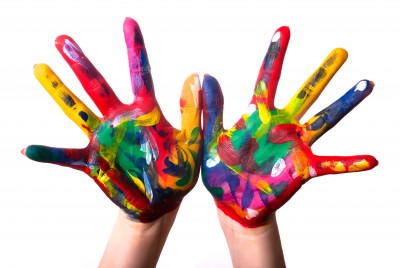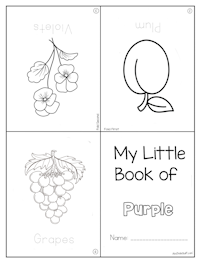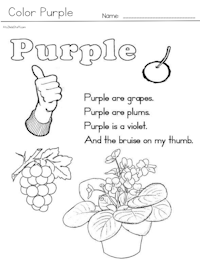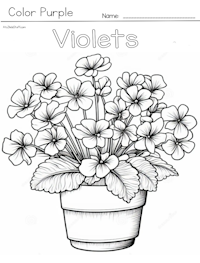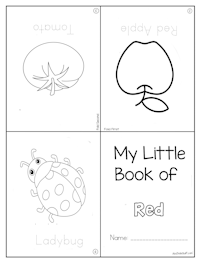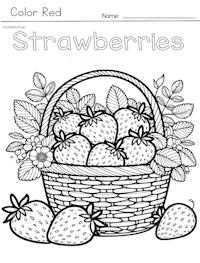Colors -- Preschool & Kindergarten
Purple
Art
Purple Playdough
Give the children a small ball of red and a small ball of blue playdough. After the children have played with it a time ask the children "Were did the purple playdough come from?"
Shades of Purple
Place shades of purple paint, from dark purple to lavender, at the easel.
Place shades of purple paint, from dark purple to lavender, at the easel.
Purple Print
Blue Red Mixing Colors Blue + Red = Purple
Red
Fingerplays/Songs
Mary Wore a Red Dress
(Have children stand if they are wearing something of that color.)
Mary wore a red dress
red dress red dress
Mary wore a red dress all day long
Art
Red Collage
Need: magazines
Let each child cut out magazine pictures that contain the color red and then glue the pictures on a piece of red construction paper.
Apple Tree
With a brown marker draw a tree on blue construction paper. Place on the table small containers of red paint. Have children dip a finger into the red paint and place red fingerprints onto the tree to make it an apple tree.
Snack
Snack Ideas:
cranberry juice, red apple slices, cherry gelatin, strawberry tars, cherry tarts, cherries.
Red Print
Story
The Color Kittens (A Little Golden Book)
by Margaret Wise Brown
The Color Kittens (A Little Golden Book)
Once there were two color kittens with green eyes, Brush and Hush . . .So goes the rollicking tale of two pouncy kittens who make all the colors in the world. First published more than 50 years ago, this much-requested title is now available as a Little Golden Book Classic, with its original cover!
Video
Color Mixing
Fingerplay/Songs
Color Recognition Rhyme
Need: copies of the eight basic colors available to teach this little rhyme about colors. Use any tune that works.
Red and yellow, brown and green,
Purple, orange, black and blue.
I can sing a rainbow, sing a rainbow,
I can sing a rainbow too.
Contributed by Dorothy Watkins
Art
Color Books
Need: construction paper in a variety of colors
Staple several different colors of construction paper together to make a book.
Children look and cut out magazines pictures that match the color of the book's paper. Then the child glues the magazine picture with the dominate color onto the matching book page.
Modern Art Mazes
Need: paint (red & yellow) , paper, marbles, boxes or pie tins, spoons
Pour paint onto plates. Place a sheet of paper in each box. Ask children to dip the marbles into the paint, spoon them out, and gently drop them onto the paper. By moving the boxes children can create maze-like designs. Remind children to try to keep the marble in the boxes.
Pendulum Painting
Need: long string, ziplock bag, paint, paper to paint on, newspaper
For this activity you need a lot of space. Attach one end of the string to the ceiling in the middle of the room. Fill the ziplock bag with paint and zip it. Attach the bag to the other end of the string. Cover the surrounding area with newspaper to make clean up easier. Place paper on the floor under the string to paint on. When ready, snip off the corner of the bag and let it fly, painting lines on the paper. It is a bit messy, but the fun is worth it!
To do outside: Turn 2 chairs backwards. Place a stick (broom) between the chairs. Tie the string with the paint filled zip-lock baggie to the broom stick.
Contributed by: Cristi Bartholic
Stained Glass
Need: White construction paper, tissue paper, shapes, paintbrushes, liquid starch
Children can create their own "stained glass" by placing tissue paper shapes on white construction paper and brushing them lightly with the liquid starch. Children can experiment by overlapping the pieces to create different colors, as well as different designs.
Group Time
Letter Carrier
Cut different colored construction paper into rectangles. One child is the letter carrier. Have the child deliver a letter to each of the other children. When all the letters have been delivered, let each child stand up and tell what color he/she received. Collect and redistribute.
Pass the Color
Need: different colored cards
Have children sit in a circle. Give some of the children a colored card. Establish which way the cards will be passed. Do a practice pass.
Start the music. Have the child pass the colored cards around the circle. Stop the music. Have each child name the color that he/she is holding. Then start the music and play again!
Contributed by: Mary Baker
Math
Color Sort
Place three bags labeled red, yellow, and blue and a variety of colored blocks on a table. Write the label of each bag with a colored marker. The children can sort the blocks by placing them in the matching colored bag.
Science
Colored Jars
Collect five large clear jars. Fill 3 with red water, 1 with yellow water, and 1 with blue water. Show children the 3 red jars. Discuss the color red. Show them the yellow jar. Add yellow to red. What happens? Add blue water to other red jar. What happens? Discuss color mixing
Color Cubes
Need: ice cube tray, food coloring, clear glass or tall baby food jar.
After filling the ice cube tray with water, add drops of red, yellow and blue the compartments. After they are frozen, place a red cube and two yellow cubes in a glass. As the cubes melt watch what happens!
Do the same for yellow and blue and red and blue. It is fun to watch the ice melt and change into another color.
Mixing Colors
Place 2 to 3 ice cube trays and cups filled with red, yellow, and blue colored water on the science table. Using an eyedropper, the children can experiment mixing colors in the ice cube trays. Smocks should be provided to prevent stained clothing.
Rainbows
Need: Jar of Cold Water, Food Coloring
Place a clear jar of cold water on the table so it can be undisturbed but observed. Add drops of food coloring and watch the "rainbows" appear. Try varying the water temp, consistency (add oils, etc), stirring and so on. Shows color mixing, properties of matter, etc.
Colored Water
Need: ice cube tray, food coloring, clear glass or tall baby food jar.
Make ice cubes of various colors using either food coloring or kool-aid. Serve ice water for snack time and allow the children to choose an ice cube. If you are learning about color mixing, make the ice cubes in the primary colors and have the children each choose two ice cubes.

